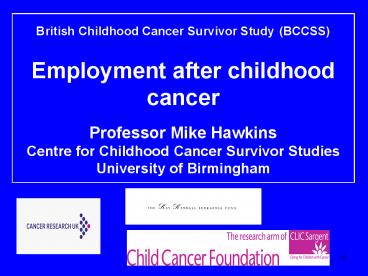British Childhood Cancer Survivor Study BCCSS PowerPoint PPT Presentation
1 / 12
Title: British Childhood Cancer Survivor Study BCCSS
1
British Childhood Cancer Survivor Study
(BCCSS)Employment after childhood cancer
Professor Mike HawkinsCentre for Childhood
Cancer Survivor StudiesUniversity of Birmingham
2
British Childhood Cancer Survivor Study
Employment status
Characteristics of the BCCSS
Population-based (study cohort was ascertained
through the National Registry for Childhood
Tumours) Large-scale (17981 survivors were
eligible for inclusion and of these 14836 were
alive and aged 16 years) Involved direct
contact with survivors (a self-completion
questionnaire was sent out to all survivors who
were alive and aged 16 years) Addresses a wide
spectrum of health and social outcomes which
might be adversely affected by childhood cancer
and its treatment
? ? ? ?
3
British Childhood Cancer Survivor Study
Employment status
Eligibility criteria for the BCCSS cohort
Diagnosed in Britain between 1940 and 1991 Aged
under 15 years at diagnosis Survived at least 5
years
? ? ?
4
British Childhood Cancer Survivor Study
Employment status
- Objectives
- To compare employment status of British adult
survivors of childhood cancer with that expected
from the general population. - The general population data was taken from the
General Household Survey undertaken in 2002.
5
British Childhood Cancer Survivor Study
Employment status
Measurement of employment status
National Statistics Socio-economic Classification
(NS-SEC, used for all official statistics and
surveys since 2001) Available for 9731
survivors in the BCCSS cohort 15730 individuals
from the GHS
6
British Childhood Cancer Survivor Study
Employment status
Based on NS-SEC individuals were classified into
4 groups
- Managerial / Professional
- Intermediate
- Routine / Manual
- Unemployed / Never worked
- Full time students were excluded. All analyses
were undertaken controlling for age, gender and
educational attainment.
7
British Childhood Cancer Survivor Study
Educational attainment
Comparison with general population data, all
survivors (controlling for age and gender)
At all stages of educational attainment that were
considered survivors of childhood cancer were
found to perform worse than the general
population.
8
British Childhood Cancer Survivor Study
Employment status
Comparison of proportion in employment
9
British Childhood Cancer Survivor Study
Employment status
Comparison of the proportion of employed
individuals in managerial or professional
occupations
10
British Childhood Cancer Survivor Study
Employment status
Comparison of the proportion of employed
individuals in occupations classified as
intermediate or above
11
British Childhood Cancer Survivor Study
Employment status
Conclusions
- Survivors of leukaemia, Wilms tumour and bone
sarcomas experience higher levels of employment
when compared to the general population. Only
CNS tumour survivors experience lower levels of
employment than the general population. - Apart from survivors of leukaemia and CNS tumours
there is no difference in the proportions of
survivors in managerial / professional
occupations compared to the general population.
The proportion of survivors of leukaemia and CNS
tumours in managerial / professional occupations
is less than expected from the general
population. - Survivors of neuroblastoma, retinoblastoma,
Wilms tumour and bone sarcomas were more likely
to be in non-manual occupations compared to the
general population. Only survivors of CNS
tumours were more likely to be in manual
occupations compared to the general
population.
12
- ACKNOWLEDGEMENTS
- The British Childhood Cancer Survivor Study
(BCCSS) is a national collaborative undertaking
guided by a Steering Group comprising Professor
Douglas Easton (chair), Professor Michael Hawkins
(secretary), Dr Helen Jenkinson, Dr Meriel
Jenney, Dr Emma Lancashire, Professor Kathryn
Pritchard-Jones, Professor Michael Stevens and Mr
Charles Stiller. The BCCSS benefits from
contributions from the contributions of the
Childhood Cancer and Leukaemia Group (Officers,
Centres and individual members), the Childhood
Cancer Research Group, and the Regional
Paediatric Cancer Registries. The BCCSS
acknowledge the collaboration of the Office for
National Statistics, the General Register Office
for Scotland, the National Health Service Central
Registers, the regional cancer registries, Health
Authorities and Area Health Boards in providing
general practitioner names and addresses and
general practitioners nationwide who facilitated
direct contact with survivors. We are
particularly thankful to all survivors who helped
by completing a 40 page questionnaire. The BCCSS
would not have been possible without the support
of our three funders Cancer Research UK, the Kay
Kendall Leukaemia Fund and CLIC Sargent to whom
we offer our profound thanks. Finally, thanks to
Jane Cook, Dr Clare Frobisher, Julie Kelly, Dr
Emma Lancashire, Sue Leeke, Raoul Reulen, Dr
Aliki Taylor and Dave Winter who have given many
years of dedicated work to bring the BCCSS to
fruition.

